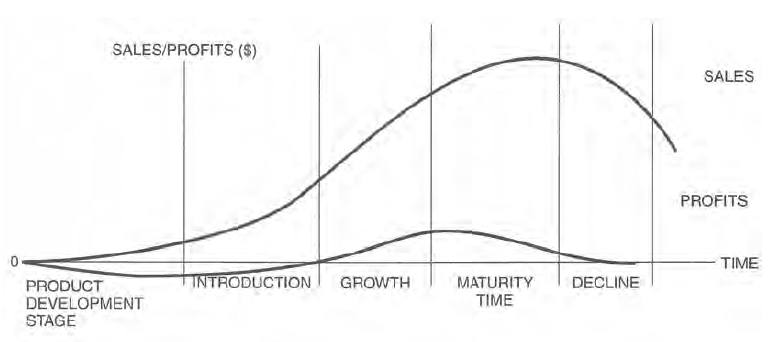A company has to be good at both developing new products and managing them in the face of changing tastes, technologies, and competition. Evidence suggests that every product goes through a lifecycle with predictable sales and profits, as illustrated in Figure 7.4. As such, the manager must find new products to replace those that are in the declining stage of the product lifecycle and learn how to manage products optimally as they move from one stage to the next.
The five stages of the PLC and their components can be defined as follows:
- Product development: the period during which new product ideas are generated, operationalized, and tested prior to commercialization.
- Introduction: the period during which a new product is introduced. Initial distribution is obtained and promotion is obtained.
- Growth: the period during which the product is accepted by consumers and the trade. Initial distribution is expanded, promotion is increased, repeat orders from initial buyers are obtained, and word-of-mouth advertising leads to more and more new users.
- Maturity: the period during which competition becomes serious. Towards the end of this period, competitors' products cut deeply into the company's market position.
- Decline: the product becomes obsolete and its competitive disadvantage result in decline in sales and, eventually, deletion.

It should be noted that the predictive capabilities of the product lifecycle are dependent upon several factors, both controllable and uncontrollable, and that no two companies may follow the same exact pattern or produce the same results. For example, differences in the competitive situation during each of these stages may dictate different marketing approaches. Some argue that the competitive situation is the single most important factor influencing the duration of height of a product lifecycle curve. A useful way of looking at this phenomenon is in the terms of competitive distinctiveness. Several years ago, Dean suggested that a separation exists between products of lasting and perishable distinctiveness. Often, new products may, upon introduction, realistically expect a long period of lasting distinctiveness or market protection—through such factors as secrecy, patent protection, and the time and cash required to develop competitive products. However, almost all new products can expect fewer than 5, 10, or 15 years of market protection.5
Of course, changes in other elements of the marketing mix may also affect the performance of the product during its lifecycle. For example, a vigorous promotional program or a dramatic lowering of price may improve the sales picture in the decline period, at least temporarily. The black-and-white TV market illustrated this point. Usually the improvements brought about by non-product tactics are relatively short-lived and basic alterations to product offerings provide longer benefits.
Whether one accepts the S-shaped curve as a valid product-sales pattern or as a pattern that holds only for some products (but not for others), the product lifecycle concept can still be very useful. It offers a framework for dealing systematically with product management issues and activities. Thus, the marketer must be cognizant of the generalizations that apply to a given product as it moves through the various stages. This process begins with product development and ends with the deletion (discontinuation) of the product.
- 2509 reads






